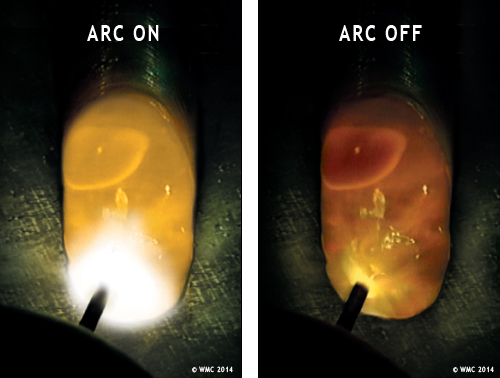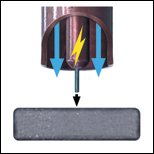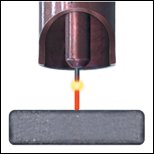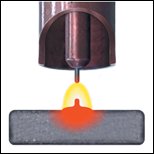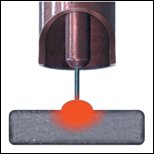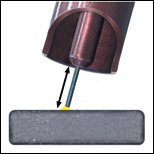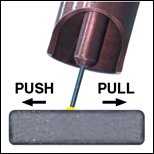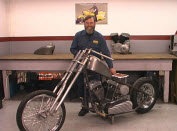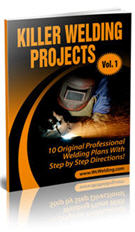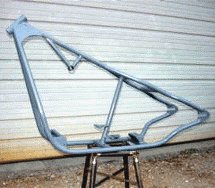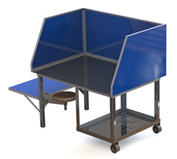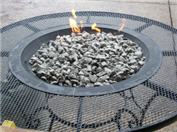GMAW (MIG) Short Circuit Metal Transfer Explained!
The article and images on short circuit metal transfer were created by Steve Bliele and he gave us exclusive rights to use it on our website...
Short Circuit is considered to happen at voltage settings under 22 volts and is the most common type of metal transfer for general purpose GMAW (MIG) wire feed welding.
The welding wire continually touches the base metal and arcs in an "arc on/ arc off" cycle that allows the molten weld puddle to cool enough so that welds can be made in any position, flat, horizontal, vertical, and overhead.
When the wire feed gun trigger is pulled, shielding gas begins to flow, the welding wire is energized, and the drive rolls feed wire:
As the wire touches the metal, electrical resistance causes the welding wire to heat up until it pinches off, creating an arc:
Electrically energized gasses surrounding the arc form a molten weld pool, fusing the filler metal and base metal:
The continuously fed wire overcomes the heat of the arc touching the metal again until it heats up, pinches off, and arcs:
This Short Circuit "arc on arc off" cycle happens 50 to 250 times a second depending on voltage and wire speed settings:
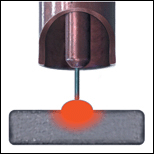
Push Versus Pull MIG Welding Technique:
The welding machine should be set up to produce the maximum number of Short Circuit cycles. This can be achieved by adjusting either the voltage or the wire-speed to produce the smoothest sounding arc.
While the "arc on arc off" cycle does allow
the puddle to cool enough for all position welding, there is potential
for lack of weld fusion. Welding machine settings, metal preparation,
and
good welder technique are important in constantly making good welds.
The
recommended Wire Extension (from the contact tip to the base metal) is
1/4" to 3/8". Pulling the gun away increases
the wire extension and causes the wire to pre
heat, reducing the amperage necessary to burn off the wire and reducing
the energy (heat) at the weld. Holding the gun
closer increases the amperage and heat at the
weld:
GMAW (MIG) Short Circuit can either be "pushed" or "pulled". Pulling the weld, with the wire on the leading edge of the puddle, will produce better penetration and build up more weld. Pushing the weld, with a slightly faster travel speed, tends to flatten the weld and reduce penetration for welding thinner gauge metals:
Short Circuit GMAW (MIG) does not provide a lot of arc force to burn off surface impurities on the metal, and these impurities take the heat that should be going to melt the base metal:
- Take the time to remove any dirt, paint, rust, and even the mill scale on new metal. In most cases, you’ll find it takes longer to prepare the metal than actually weld it.
- Try for a perfect fit up. Bevel, grind a groove or leave a gap on butt joints and some corner joints. Along with providing better penetration, the edges of the bevel, groove or gap melt easily and help weld fusion along the outside edges of the weld.
- Practice good welder technique. Try to maintain a consistent gun angle and wire extension to keep the amount of heat and filler metal deposit uniform.
- Welding is a lot more fun when it works. Take your time, work safely, and have a good time. Thanks for reading, Steve Bleile
- Note: There are two other types of GMAW metal transfer. With an "open arc" (the arc is on all the time), Spray Transfer uses high voltage (over 22V) with an argon rich shielding gas (90%ar/10%co2) to form a highly energized, concentrated arc stream that breaks the wire into small droplets. Because of the amount of heat and filler metal deposit, Spray Transfer is generally limited to the flat position or horizontal fillets, and is used in the welding industry for high speed production welding
- Globular Transfer happens when high voltage is used with a co2 or 75/25 shielding gas. Because the energy isn't concentrated, the wire melts in globs that can escape the broader arc stream. While Globular Transfer does make good welds at relatively fast travel speeds in the flat position, it is generally avoided because of the excessive weld spatter.
Steve's Welding Training DVD's (highly recommended - used by over 4000 training institutions):
Welding Plans:
New! Welding Table
New! Log Splitter
Top Projects:
